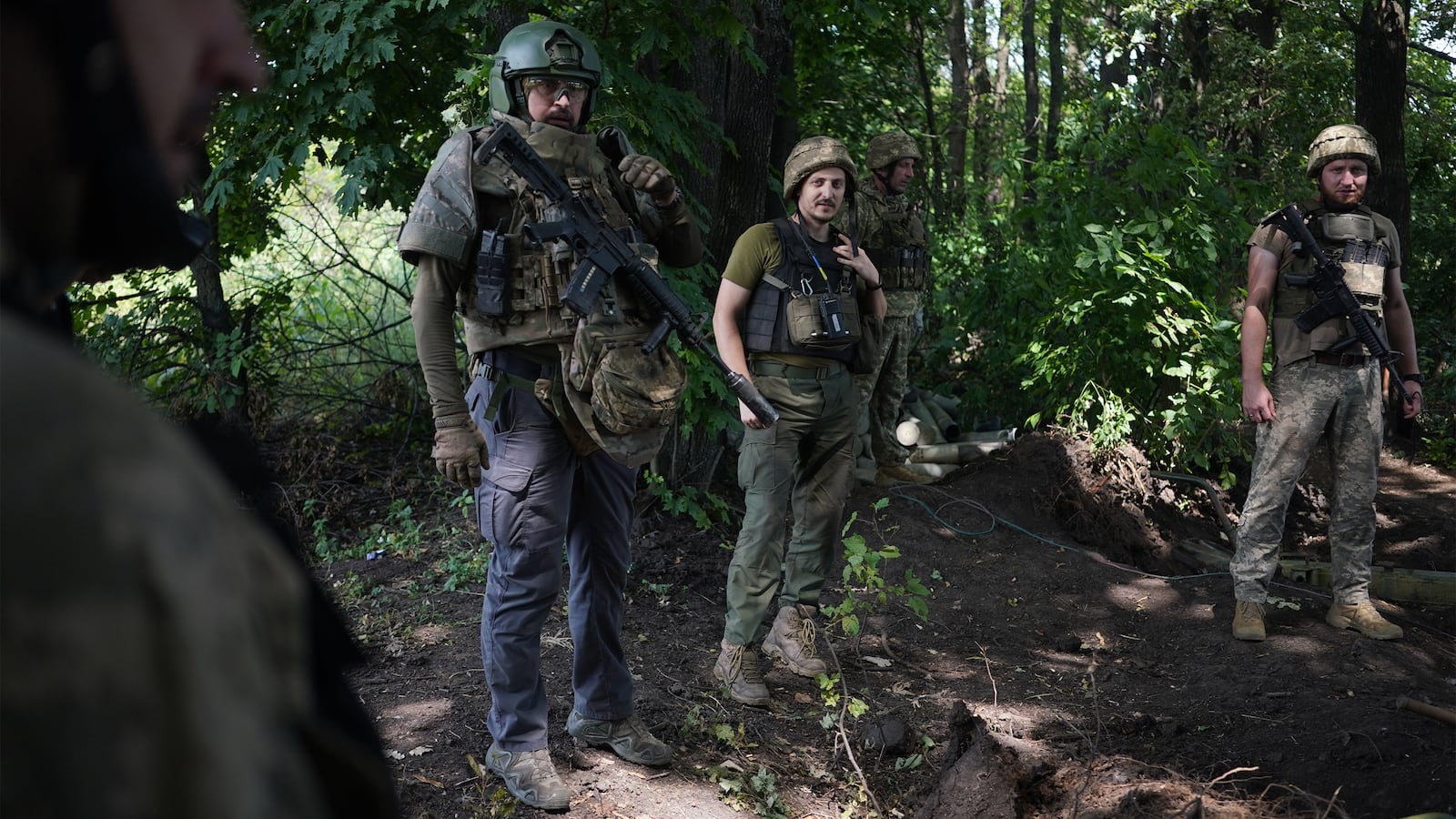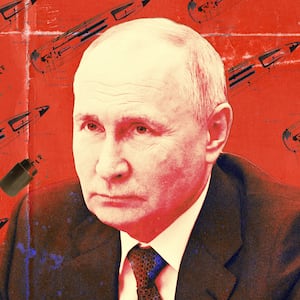KYIV—The Kupiansk and Lyman axis of eastern Ukraine is rapidly spiraling into one of the hottest flashpoints of the war. The Ukrainian military reports that Russia has packed the region with more than 100,000 soldiers and 900 tanks—almost as many as the USSR deployed during the occupation of Afghanistan.
For some on the front line, it’s a sign that Vladimir Putin is desperate for a chink of light in his disastrous war.
“Putin has to sell at least some victory to somehow get out of his failed operation,” Svyatoslav Dubina, a Ukrainian platoon commander defending a position in that area, told The Daily Beast in an interview.
Battles in the region, including in the town of Kupyansk, have been so grueling that Dubina predicts survivors will share “hellish” stories about them for generations to come.
“There is a place called Serebryansky forest, where we have had worse battles than in the city of Bakhmut, since there are no concrete walls to protect us, just trees and the trenches we dug,” Dubina said. “We can only win this war against superior Russian forces with high technologies—for that we need to be smart and our Western allies should be supplying the high-precision weapons right now without waiting for nine months, like last year.”
Russia is hell-bent on taking control of Serebryansky forest, seen as a gateway to the city of Lyman, which Ukraine liberated last year just a day after Russia claimed it had annexed the town. According to Ukrainian intelligence, Putin had ordered his troops to occupy the entire Donetsk and Luhansk regions of Ukraine by March this year. But there’s no controlling those regions without winning the fight for the forest first—and that plan has failed.

A group of Ukrainian soldiers walk in the direction of Lyman and Kreminna in Donetsk Oblast, Ukraine on July 25, 2023.
Diego Herrera Carcedo/Anadolu Agency via Getty ImagesThat doesn’t mean the Russians have lost their shot at re-taking Donetsk and Luhansk entirely, though.
“The sweetest scenario for Russians would be if our troops retreated to the river of Seversky Donetsk—that would mean Russia has taken over the Luhansk region,” 49-year-old Dubna said. “That could only happen if they managed to break through our defense in Luhansk region.” The Russian operation in the Luhansk region is also known as “big Gerasimov’s design,” Aleksiy Arestovych, a Kyiv-based analyst and former adviser to Ukrainian President Volodymyr Zelensky, told The Daily Beast.
“Russians realize that we are ready for our main push in the south, so they decided it was time to distract in the east and reinforced that part of the front with 100,000 troops and 900 tanks,” he said. “But that is a very difficult place for Russian offensive—hills, forests, and rivers.”
By now, Russian commanders have realized that even occupied territories can be retaken, as was the case in Kyiv, Chernihiv, Kherson, Kharkiv, Luhansk, and other regions of Ukraine. The head of Russia’s Wagner mercenary army, Yevgeny Prigozhin, said in a video posted on Wednesday that the situation on the front “is a shame” for the Russian army—given the sheer volume of cannon fodder and tanks at their disposal.

A Ukrainian serviceman with the 95th Brigade reloads artillery shells in the region of Lyman, Ukraine, on April 7, 2023.
Kai Pfaffenbach/Reuters“Starting from early May, we have been winning in counter-battery fire because of our high-precision weapons. We have been winning in artillery battles with the Hammer, M777 Howitzer, and RCH-155 SAU—and Russians cannot do anything about it.”
Clock’s Ticking
But the Ukrainians are facing shortages in every vital resource, he added.
“We have shortages not only of high-precision weapons and missiles, but of the most basic: mortar, machine guns, of all items of ammunition,” he said. “But we have to defend the thousand-kilometer-long border with Belarus in the north and the border with Transnistria in the south, so the forces cannot be concentrated only in the Luhansk region, where there are far superior Russian forces,” Arestovych told The Daily Beast.

Ukrainian servicemen with the 95th Brigade fire artillery at the frontline in the region of Lyman, Ukraine on April 7, 2023.
Kai Pfaffenbach/ReutersDubina’s platoon arrived at their positions in Luhansk in early March, after having liberated the occupied parts of Kharkiv region. From early March until the middle of April, Dubina’s platoon was holding positions under constant fire.
“They stormed us every single day, sometimes five or six times a day. That had already been happening even before we arrived,” Dub9na, who had spent three months defending positions in the Serebryansky forest, told The Daily Beast. “Russian soldiers assigned to dig fortifications—‘kapuny’ or diggers—are supposed to dig eight meters of trenches per shift…. they were digging even under our artillery fire in a hurry to complete the trenches”

Ukrainian platoon commander Svyatoslav Dubina.
Svyatoslav DubinaSince the beginning of the counteroffensive on June 8, Ukrainian forces have recaptured about 300 miles of its territory, pushing their way through Russian mine fields and through brutal battles. If they were better equipped, they could have done even better, Dubina said,
“Remote observation video equipment, which costs around $15, could have replaced four soldiers we need to hold the surveillance positions during 24 hours on the front,” Dubina said. “To win this war we need to save all the lives of our soldiers. We could only do it by equipping our forces with more drones and technology. But we were waiting for months and months for the ammunition, until our commanders basically screamed for help—we lost time.”
Michael Bociurkiw, a senior fellow of the Atlantic Council, shared similar concerns about ammunition.
“Russian forces have poor morale and are poorly equipped, but the strategy they are using is unfortunately the gap in time to supply the ammunition. Given the situation Ukraine might begin to strike long-ranged missiles—whether the West likes it or not—at key military targets within Russian-occupied territory,” he told The Daily Beast, adding: “It is going to escalate.”







